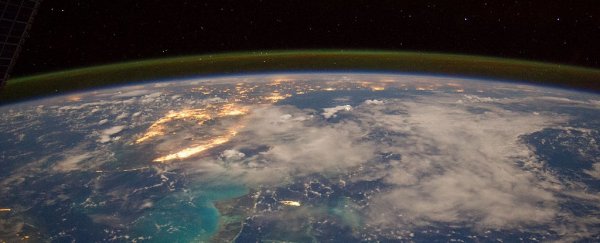There's something just so incredibly satisfying about the idea of the Kármán line – the invisible boundary between Earth's atmosphere and space. Situated at an altitude of 100 kilometres (62 miles), it represents the point at which aeronautics end, and astronautics take over.
But maybe it's a little too neat, according to a new paper that seeks to burst the 100-kilometre bubble. The boundary, the new research argues, should be some 20 kilometres (12.4 miles) or so closer to Earth.
That's the thinking of astrophysicist Jonathan C. McDowell of the Harvard-Smithsonian Centre for Astrophysics, at least, which is based on the orbital and suborbital trajectories of satellites.
You see, when a craft flies high into the atmosphere, the gases gradually grow thinner and thinner, providing less lift. To stay airborne, a craft needs to accelerate to higher and higher speeds; eventually, it reaches a point where the speed needed to keep the craft in the air is the same as the speed needed to orbit Earth.
This is called orbital velocity, and the 100-kilometre standard, as adopted by the Fédération Aéronautique Internationale, is more or less the height at which a plane reaches this speed.
But it's not just a name. It's also important to define the boundary of space in a jurisdictional sense. Below a certain boundary, airspace can be said to belong to the country below it, whereas above that line, free space exists, and satellites should theoretically be allowed to fly freely.
So back to McDowell. He chose for his proposed boundary the 80-kilometre mark, just below the mesopause - the boundary between the lower mesosphere and the upper thermosphere, and the coldest point in the Earth's atmosphere.
And this is because of the satellites. McDowell analysed over 90 million points of orbital data from 43,000 satellites dating back to 1957, using archives maintained by the North American Air Defence Command.
Most of the satellites fly pretty high, but he identified 50 that flew below the 100-kilometre mark, down as low as the 80-kilometre mark, over two or more complete revolutions of Earth.
"Are you going to say [these satellites are] in space and then not in space every 2 hours?" he told Science. "That doesn't seem very helpful."
His next step was to look at the altitude point at which satellites tend to return to Earth - and he found that, at a range between 66 kilometres and 88 kilometres, aerodynamic forces transition from dominant to negligible.
His points certainly have precedent. Although the US doesn't recognise an official space boundary, the US Department of Defence awards astronaut wings to any pilot who has flown above the 80 kilometre point. And there have been decades of debate about where the line should be set.
Other scientists not involved in McDowell's paper told Science that he made a very good argument for the 80-kilometre mark; planetary scientist Alan Stern of the Southwest Research Institute called it a "cogent argument", while Virgin Galactic CEO George Whitesides said McDowell makes a "solid case".
That doesn't mean we're going to see any commonly used definitions change soon, though: McDowell first proposed his 80-kilometre boundary line in 1994 - over 25 years ago. Perhaps we need a new term for it instead: the McDowell line.
The paper will appear in the October edition of the journal Acta Astronautica, and has been published online.
